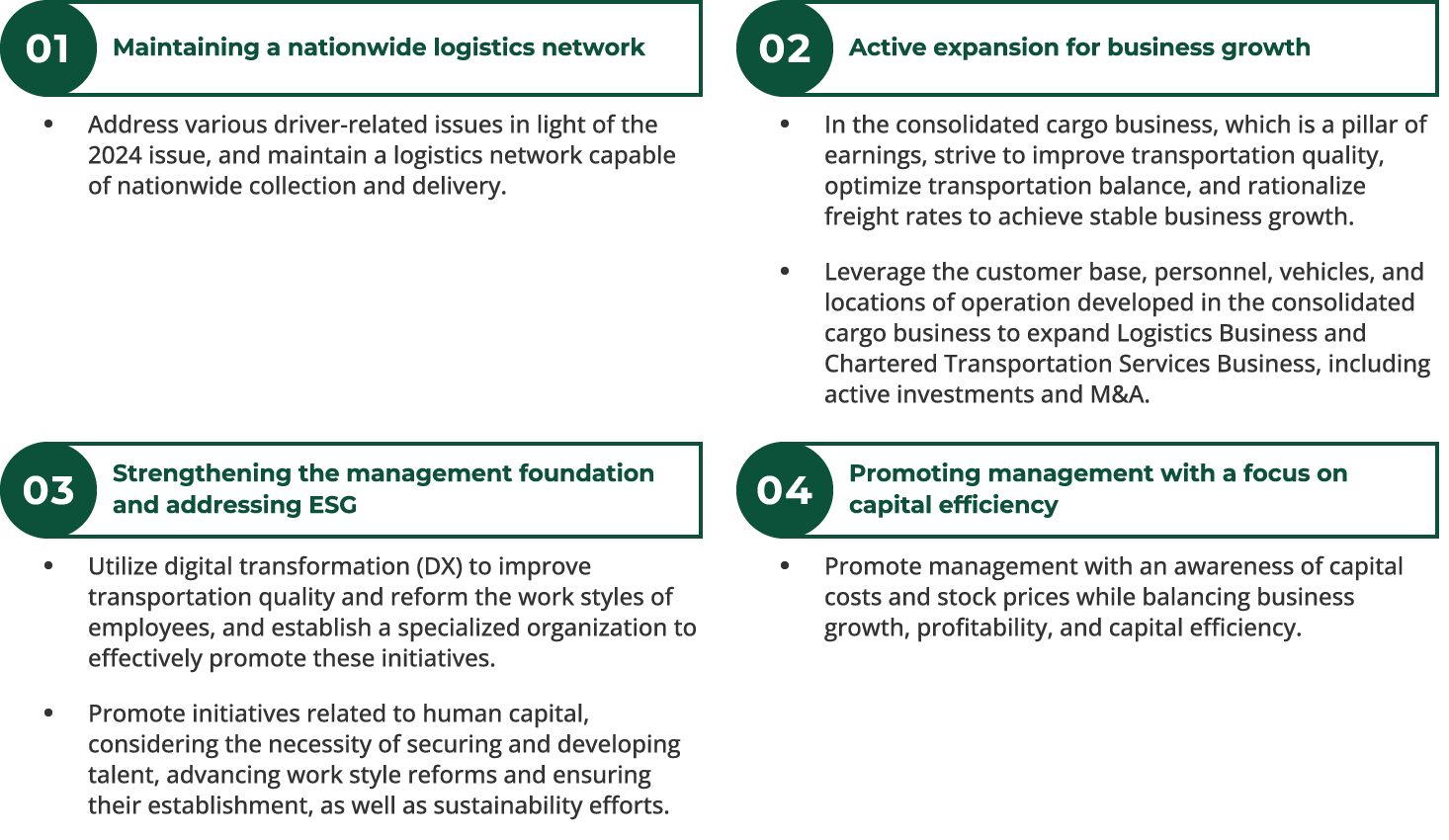Management Plan
Approach to the 6th Medium-Term Management Plan

Basic Policy

Business objectives of the 6th Medium-Term Management Plan (FY2026)
(Unit: 100 million yen)
| Key management indicators (6th Medium-Term Management Plan) |
FY2023 actual | FY2026 target | Change during the medium-term plan period |
|---|---|---|---|
| Sales | 2,875 | 3,400 | +525 |
| Operating profit | 104 | 180 | +76 |
| Operating profit margin | 3.6% | 5.3% | +1.7% |
| ROE | 2.8% | 6.5% | +3.7% |
Business segment goals
(Unit: 100 million yen)
| Segment | Sales | Operating profit | ||
|---|---|---|---|---|
| 2023 | 2026 | 2023 | 2026 | |
| Transporting Busness | 2,248 | 2,540 | 81 | 128 |
| Chartered Transportation Services Business | 239 | 360 | 20 | 32 |
| Logistics Business | 208 | 290 | 29 | 45 |
| International Operations Business | 107 | 130 | 3 | 7 |
| Other Business | 146 | 150 | 12 | 10 |
| Inter-segment eliminations | △75 | △70 | △42 | △42 |
| Total | 2,875 | 3,400 | 104 | 180 |
Initiatives for sustainability
| ESG category | Theme | Initiatives and goals |
|---|---|---|
| Environment | Introduction of renewable energy | Introduction and utilization of solar power generation |
| Modal shift and improvement of transportation productivity | Efficient operation of rail containers and ferry chassis, primarily through dedicated railcars | |
| Promoting environmentally friendly logistics | Active introduction of EV trucks, FC trucks, and double-trailer trucks | |
| Promoting initiatives for environmental conservation | Implementing tree-planting activities | |
| Social | Contributing to the creation of a safe, secure and prosperous society | Promotion of obtaining the G Mark Hosting traffic safety classes Conclusion of disaster prevention agreements |
| Governance | Enhancing corporate governance | Enhancing the oversight of the Board of Directors Enhancing the internal audit system |
Strategic investment and investment policy
| Investment amount | Content | Purpose | |
|---|---|---|---|
| Business growth 850 (Excluding M&A) |
300 | Vehicle purchases | Transportation efficiency and securing transportation capacity (such as double-trailer trucks) Environmental measures (such as FCEVs and BEVs) |
| 550 | Investment in bases of operation | Reconstruction of the transportation network, including addressing aging infrastructure and implementing consolidation and elimination Acceleration of growth in the Logistics Business Environmental measures (such as solar power generation) |
|
| Strengthening of the management foundation 250 |
130 | Investment in human resources | Increase in personnel costs for existing staff Increase in personnel costs for additional staff Costs related to education and training Costs related to employee benefits, etc. |
| 120 | DX/IT | Optimization of transportation and streamlining of operations Labor-saving in warehouse operations (such as GTP systems and AGVs) |
- Including costs related to the maintenance of infrastructure in existing facilities
